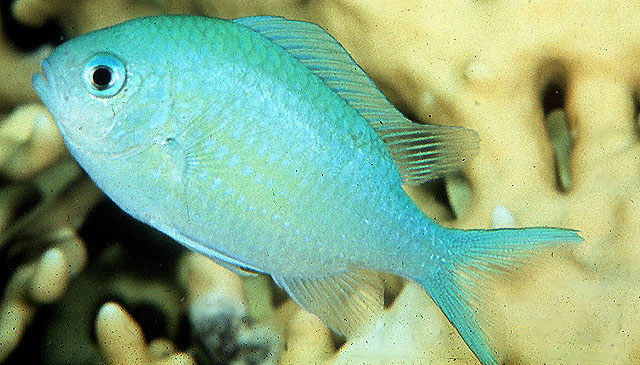| Pomacentridae (Damselfishes), subfamily: Chrominae |
| 10 cm TL (male/unsexed) |
|
reef-associated; marine; depth range 1 - 20 m, non-migratory |
| Indo-Pacific: East coast of Africa to the Line Islands and Tuamotu Archipelago; north to Ryukyu Islands, south to the Great Barrier Reef and New Caledonia. |
|
Dorsal spines (total): 12-12; Dorsal soft rays (total): 9-11; Anal spines: 2-2; Anal soft rays: 9-11. Description: Overall pale green to light blue; nesting male is yellow (changing hues during nesting), becoming blackish posteriorly; spawning coloration dorsal and anal fins change to orangey or brownish (Ref. 2334, 90102). |
| Adults are found in large aggregations above thickets of branching Acropora corals in sheltered areas such as subtidal reef flats and lagoons. Juveniles closely tied to individual coral heads (Ref. 9710). Phytoplankton feeders. Breeding is done on sand and rubble. Males prepare nest for spawning which is shared with several females. Large number of eggs spawned hatching in 2-3 days. Males guard the nest ventilating fertilized egg with their caudal fins and feeding on those which do not hatch. Oviparous, distinct pairing during breeding (Ref. 205). Eggs are demersal and adhere to the substrate (Ref. 205). Diurnal species (Ref. 54980; 113699). |
|
Least Concern (LC); Date assessed: 23 September 2021 Ref. (130435)
|
| harmless |
Source and more info: www.fishbase.org. For personal, classroom, and other internal use only. Not for publication.
